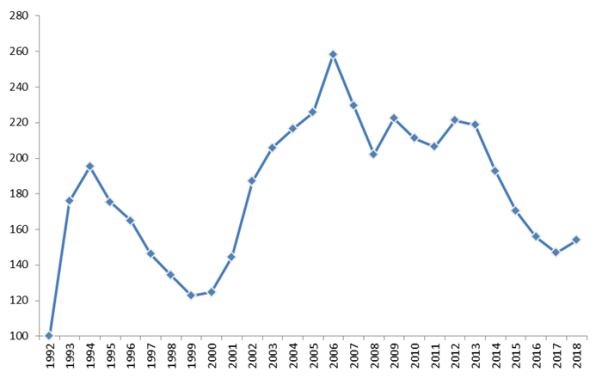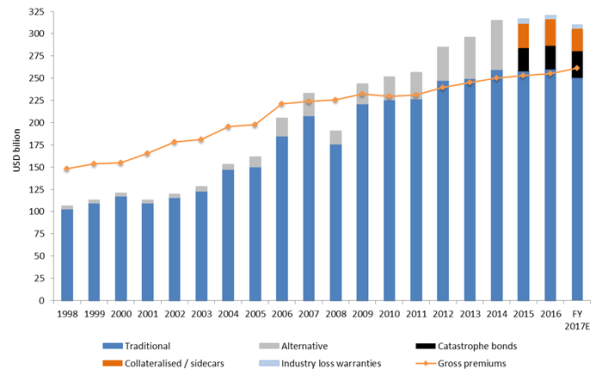JLT Re: Global Property Catastrophe Reinsurance Rate Firms Selectively
January 08, 2018
According to JLT Re, at January 1, the global property catastrophe reinsurance sector experienced upward pricing pressure following 5 consecutive years of falling rates. Pricing varied significantly across regions with pronounced firming restricted to classes and geographies experiencing the highest losses. This result was largely driven by higher loss experience after Hurricanes Harvey, Irma, and Maria (HIM) delivered a devastating triple blow to coastal regions of the United States and the Caribbean. Consequently, according to JLT Re, in 2017 the global property casualty reinsurance sector suffered its most expensive catastrophe loss year on record.
Fierce wildfires in California toward the end of the year also added to loss burdens and, when combined with other significant events, pushed insured catastrophe losses marginally above $140 billion for the first time ever in real terms. With the majority of large losses occurring in the United States, a substantial proportion of loss was borne by collateralized vehicles and insurance-linked securities (ILS) markets.
Renewal Outcomes
Ed Hochberg, chief executive officer, JLT Re in North America, said, "Property-catastrophe rate increases were most pronounced in regions impacted by loss activity, while low single-digit rises or even flat outcomes were more typical for programs without significant losses. Although reinsurers sought to stem margin compression with more substantial rate rises at January 1, 2018, many conceded ground to clients as the date neared, particularly in non-loss affected areas."
Figure 1: JLT Re's Risk-Adjusted Global Property-Catastrophe Reinsurance ROL Index—1992 to 2018

Source: JLT Re
Mr. Hochberg continued, "Figure 1 shows JLT Re's Risk-Adjusted Global Property-Catastrophe Reinsurance Rate-on-Line Index rose by 4.8 percent at January 1, 2018, with levels still below those seen in 2016. The highest increases were recorded in the United States, with rates renewing flat to up 5 percent for loss-free programs and up 10 percent to 20 percent for loss-affected business. Flat to moderately up renewals were typical for international property catastrophe business, reflecting more benign loss activity in Europe and Asia. Even with these increases, the cost of property protection remains competitive with global property catastrophe pricing approximately 30 percent below 2013 levels."
Global market property programs, such as retrocession and direct and facultative (D&F), typically saw higher rate increases at January 1, 2018, although these also fell below early market expectations. Bradley Maltese, deputy CEO of the United Kingdom and Europe, JLT Re, stated, "Despite initial indications that markets would push for more, rates for retrocession catastrophe programs were generally up by between 10 percent and 20 percent on a risk-adjusted basis, with event-based programs falling towards the lower end of this range. Lloyd's and global D&F catastrophe business was typically more loss-affected, and this translated into risk-adjusted rate increases of 15 percent to 25 percent, sometimes more for badly hit layers."
Mike Reynolds, global CEO, JLT Re, said, "Impacts spread beyond property lines as higher catastrophe and attritional losses influenced renewals for certain specialty and casualty lines. This coincided with a growing recognition that rates in some of these areas had fallen to levels that tested technical profitability after successive years of declines. As a result, programs across some specialty lines were renewed as expiring, or with modest rate increases. Negotiations for casualty renewals, meanwhile, were balanced by profitability pressures on original business and reinsurers' desire for higher rates due to the build-up of claims. Loss-free casualty programs therefore renewed close to expiring levels while accounts that experienced losses saw moderate increases. These outcomes were often accompanied by lower ceding commissions."
Capital Matters
The supply of reinsurance capital continued to drive the market during the January 1, 2018, renewal. David Flandro, global head of analytics, JLT Re, said, "2017 was the first year since 2008 in which dedicated reinsurance capital declined (see Figure 2). The sector's excess position nevertheless remains high at $45 billion or about 17 percent above gross premiums, having fallen by roughly $15 billion during the second half of the year."
Figure 2: Dedicated Reinsurance Sector Capital and Gross Written Premiums—1998 to FY 2017E

Source: JLT Re
"As a result, capacity levels continued to be plentiful across most classes of business at January 1, 2018," said Mr. Flandro. "While supply and demand dynamics initially tightened in business lines with heavy losses, pressures were offset by post-HIM capital deployments through channels such as new collateralized vehicles, post-event funds, new catastrophe bond issuances, and increased stamp capacity and preemptions. Investors responded to opportunities in both the reinsurance and retrocession markets, resulting in the replenishment of a significant portion of lost capacity in time for renewals."
Mr. Flandro concluded, "The reaction of traditional carriers and capital markets to future reserve development and loss experience will be important in shaping the reinsurance market this year. Although the bulk of 2017 losses fell within modeled expectations, there was still uncertainty over the ultimate cost to reinsurers and ILS investors during renewals. This uncertainty was compounded by the recent wildfires in California. Any significant changes to loss expectations in the coming months could potentially affect pricing."
JLT Re's Retrospective Renewal Report, which will provide a detailed assessment on renewal outcomes by individual lines of business, is being published on January 25, 2018. Copies are available.
(JLT Re's ROL index is risk-adjusted, meaning changes to exposures, as well as premiums, are incorporated.)
January 08, 2018





